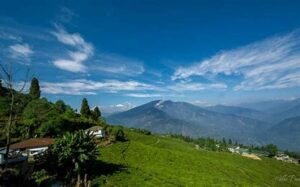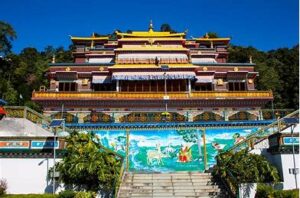Nestled within the North Sikkim district of India, Yumthang Valley is an ecological marvel and a vital component of the Eastern Himalayas’ biodiversity. Popularly referred to as the “Valley of Flowers,” the region is renowned not only for its breathtaking seasonal blooms but also for its strategic ecological importance, fragile high-altitude ecosystem, and deep cultural associations with the indigenous communities of Sikkim. While much of the discourse surrounding Yumthang often veers toward travel and visual grandeur, an academic perspective reveals layers of botanical, environmental, and cultural richness that define its true importance.
Geographic and Ecological Overview
Located at an elevation of approximately 3,564 meters (11,693 feet) above sea level, Yumthang Valley lies within the Shingba Rhododendron Sanctuary in the northern reaches of Sikkim, close to the Indo-Tibetan border. The Teesta River, originating from the high-altitude glaciers of the eastern Himalayas, meanders through the valley, lending it both life and landscape character.
The topography of Yumthang Valley is typical of a high-altitude temperate zone, marked by snow-capped mountains, glacial streams, and verdant meadows. The valley remains under snow during the winter months, while spring and summer witness an eruption of floral life, giving the region its famed epithet. It is during this period—from late March to mid-June—that over 24 species of rhododendrons and numerous alpine flora bloom, turning the valley into a vast carpet of vibrant colors.
Botanical Significance
The botanical richness of Yumthang is largely attributed to its inclusion in the Shingba Rhododendron Sanctuary, which spans about 43 square kilometers. The sanctuary is home to an extensive variety of rhododendron species, making it a subject of interest for botanists and ecologists alike. Species such as Rhododendron niveum (the state tree of Sikkim), Rhododendron arboreum, Rhododendron cinnabarinum, and Rhododendron campanulatum thrive here, alongside a variety of endemic and rare high-altitude herbs and shrubs.
Yumthang’s floristic profile also includes primulas, potentillas, saxifrages, and anemones, among others. These alpine meadows, known as “bugyals” in local terminology, play a critical role in maintaining the Himalayan ecosystem by acting as pollinator corridors and carbon sinks. Moreover, the valley’s flora has long-standing uses in traditional medicine, particularly among the local tribal communities such as the Lepchas and Bhutias.
Conservation and Environmental Challenges
Despite its ecological vibrancy, Yumthang Valley faces several environmental challenges that threaten its long-term sustainability. Chief among them is the threat posed by increasing anthropogenic pressure, including unregulated tourism, road construction, and the growing presence of plastic waste. The fragile alpine ecosystem is particularly vulnerable to soil erosion, water contamination, and habitat fragmentation.
Climate change adds a more insidious threat to Yumthang’s future. Altered snowfall patterns, glacial retreat, and warming temperatures are gradually transforming the valley’s phenological rhythms—such as flowering seasons—and threatening plant biodiversity. Studies conducted by the Botanical Survey of India and various ecological research institutions have pointed out that some rhododendron species are already showing signs of stress, reduced flowering periods, and shrinking distribution ranges.
In response, efforts are being made to regulate tourism and promote eco-friendly practices. The Sikkim Forest Department, along with NGOs and local communities, have implemented waste management programs, awareness campaigns, and biodiversity monitoring schemes. However, sustainable conservation of Yumthang requires coordinated research, policy-level interventions, and community participation.
Cultural and Spiritual Dimensions
Beyond its ecological relevance, Yumthang Valley holds cultural and spiritual significance for the indigenous communities of North Sikkim. The valley is often referred to as a “sacred landscape” by the Bhutia and Lepcha peoples, who believe that the region is inhabited by protective mountain deities.
Seasonal pilgrimages and rituals conducted in the valley further reinforce its spiritual standing. Local folklore frequently mentions the spirits of the mountains blessing the valley with flowers each year. The Yumthang Hot Spring, located near the valley, is believed to possess therapeutic properties and is visited by both pilgrims and locals for healing purposes. The spring contains naturally occurring sulfur compounds that are known to relieve rheumatic and dermatological conditions.
The practice of Dzumsa, a traditional system of self-governance unique to certain parts of North Sikkim, including Lachung near Yumthang, plays a role in the valley’s stewardship. Under the Dzumsa system, local communities make collective decisions regarding resource use and tourism management, thereby ensuring that cultural values and environmental concerns are harmoniously balanced.
Scientific Research and Botanical Studies
Yumthang has served as a living laboratory for multiple scientific inquiries, especially those focusing on alpine ecology, climate resilience, and plant-microbe interactions. Research teams from national institutions like the GB Pant National Institute of Himalayan Environment and the Botanical Survey of India have conducted several expeditions to catalog its biodiversity and assess the impacts of environmental change.
One significant area of research in Yumthang Valley involves studying the pollination mechanisms and seed dispersal strategies of alpine plants in high-altitude conditions. Given the valley’s reliance on insect pollinators—particularly bumblebees and butterflies—the decline in pollinator species has been a topic of concern. Studies have shown that rising temperatures are pushing these species to higher altitudes, disrupting established ecological networks.
Another area of academic interest lies in the ethno-botanical knowledge preserved by indigenous communities. Many herbs found in Yumthang are used in traditional healing practices, and documenting this knowledge offers insights into sustainable and culturally respectful biodiversity use.
Role in Sikkim’s Biodiversity Policy
Yumthang Valley is a vital node in Sikkim’s broader biodiversity and sustainability framework. Sikkim is India’s first fully organic state and has implemented stringent conservation policies to preserve its natural heritage. Yumthang, being a biodiversity hotspot, is integral to Sikkim’s compliance with international conservation agreements such as the Convention on Biological Diversity (CBD).
The state government has incorporated the Yumthang Valley into its State Biodiversity Strategy and Action Plan (SBSAP), focusing on habitat protection, environmental education, and community-based eco-tourism. In addition, educational institutions are encouraged to include Yumthang in field study programs to cultivate early environmental awareness and scientific curiosity among students.
Tourism and Responsible Access
Although tourism is not the primary lens through which this article examines Yumthang, its influence on the valley cannot be ignored. The valley receives a substantial number of visitors annually, particularly during the flowering season. While this influx generates economic opportunities for local residents, it also strains the ecosystem.
To address this dichotomy, the state promotes responsible and low-impact tourism. Permits are required to access the area, and visitors are advised to respect the ecological sensitivity of the region. Involving local guides and encouraging home-stay accommodations ensures that benefits of tourism are equitably distributed while maintaining the valley’s ecological balance.
Educational signage, restricted access zones, and seasonal regulations are also being introduced to manage footfall and minimize degradation. These measures reflect a growing understanding that human engagement with Yumthang must shift from exploitative to symbiotic.
Conclusion
Yumthang Valley stands as a striking testament to the interplay between natural beauty and ecological depth. More than just a scenic marvel, it is a living ecosystem, a site of cultural memory, and a focal point for scientific study. Its status as the “Valley of Flowers” is not merely poetic—it reflects a deep ecological reality supported by a complex matrix of flora, geography, traditional knowledge, and adaptive conservation efforts.
Preserving the integrity of Yumthang Valley demands a multi-disciplinary approach, drawing from ecology, anthropology, climate science, and policy. Only through such integrated efforts can the valley’s legacy be sustained for future generations—not just as a tourist destination, but as an emblem of the Eastern Himalayas’ fragile and wondrous biodiversity.




